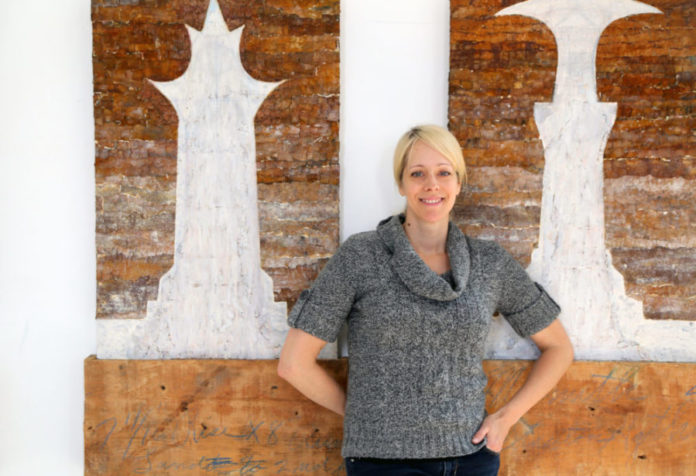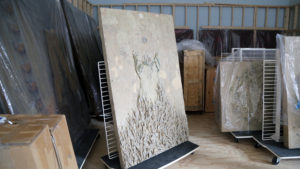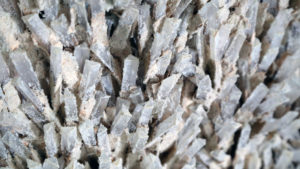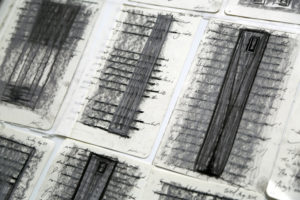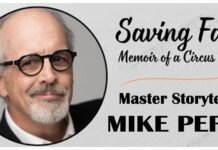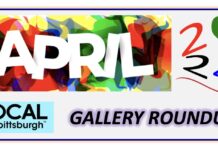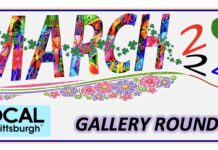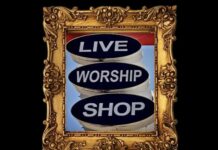Story and Photos by: David Bernabo
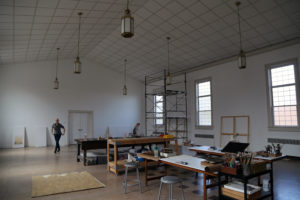 Bright daylight enters through the high windows of a former Methodist church–now a home art studio–gently lighting a new series of Brenda Stumpf’s tactile art. Sculptures rest on pedestals, assemblages of wood and tattered paper hang on the newly painted white walls. This work is meticulous in its craft, but made to look haphazard, weathered, eternal.
Bright daylight enters through the high windows of a former Methodist church–now a home art studio–gently lighting a new series of Brenda Stumpf’s tactile art. Sculptures rest on pedestals, assemblages of wood and tattered paper hang on the newly painted white walls. This work is meticulous in its craft, but made to look haphazard, weathered, eternal.
“They’re sophisticated in that there is a formality to them,” says Stumpf about her recent body of work. “But if you get up close they’re not refined in their making. I like the ruggedness of these pieces.”
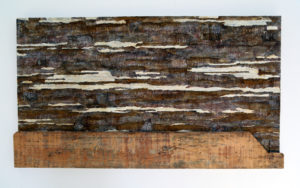 This ruggedness is a slight pivot from Stumpf’s recent Cavomyrt painting series, which embeds objects in elaborate, earthen environments, recalling youth through the use of childhood dresses.
This ruggedness is a slight pivot from Stumpf’s recent Cavomyrt painting series, which embeds objects in elaborate, earthen environments, recalling youth through the use of childhood dresses.
In the back of the studio, covered with protective plastic, a number of works from Stumpf’s last few shows rest, awaiting a more permanent storage solution. Like her new pieces, these works represent a clear vision and a practiced hand at creating otherworldly settings of myth, memory, and secrets.
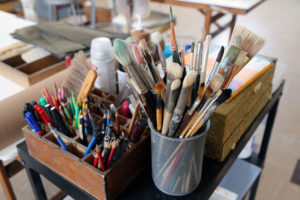 While Stumpf knew art would be a part of her life from an early age, the path to making these highly evocative, layered works was a slow evolution. “If you saw my early work, we would all laugh,” says Stumpf. “It wasn’t horrible, but it was lyrical and colorful–words that you would never attribute to the work that you see now.”
While Stumpf knew art would be a part of her life from an early age, the path to making these highly evocative, layered works was a slow evolution. “If you saw my early work, we would all laugh,” says Stumpf. “It wasn’t horrible, but it was lyrical and colorful–words that you would never attribute to the work that you see now.”
Stumpf considers herself a self-taught artist, citing that a two-year stint at the Columbus College of Art and Design provided little insight into the process of making art. A chance visit to an exhibition of Cy Twombly’s sculptures at the National Gallery in Washington D.C. provided an unexpected catalyst.
Unfamiliar with Twombly’s work at the time, Stumpf felt a kinship with the materiality of the sculptures. “I could see these soft-lit, wet sculptures, all these encrusted objects with mythological names–things that always were appealing to me, even as young child, mystery and intrigue and ancient things.” The existence of Twombly’s work validated Stumpf’s impulses and gave her a green light to dive headfirst into working with unorthodox materials, assemblage, and myth.
 The freedom to play with material harkens back to her youth playing in the woods. “It’s the freedom that anybody that was raised in the 70s without cell phones had. We just wandered on our bikes and in the woods without any sense of time. Freedom to explore. Fantasy. You start making up things about some magical thing that lives in the woods and your friends are all buying into it.”
The freedom to play with material harkens back to her youth playing in the woods. “It’s the freedom that anybody that was raised in the 70s without cell phones had. We just wandered on our bikes and in the woods without any sense of time. Freedom to explore. Fantasy. You start making up things about some magical thing that lives in the woods and your friends are all buying into it.”
That freedom, combined with a habit of browsing National Geographic–”pyramids and naked people and weird things embedded in bones”–provided a foundation for Stumpf’s investigative spirit. “In nature, it feels like there is always something hidden in the trees or under a rock,” says Stumpf.
Stumpf’s description of her childhood is a marvelous, stream-of-consciousness that credits her parents as harbingers of her meticulous craft. Her father in the garage, surrounded by car parts, refurbishing antique cars. Her mother teaching cake decorating classes–”multi-tiered cakes with lace, icing, and flowers.” A room full of drag racing trophies–”shelves of monuments.”
The cumulative impact of this upbringing and nearness to objects can be summed up in Stumpf’s idea that “it takes as long as it takes, meaning you do the thing that needs to get done, and you can’t do the next thing until the first thing is done. You can’t go to C until you get through A and B.”
On the table in the middle of the former chapel, there are three piles of metal, showing an evolution of rusted metal sheets: a stack of large squares, smaller rectangles cut from a parent square, and small rolled tubes of metal. The tubed metal will be further manipulated and worked into a painting, but at the moment, it rests on the table waiting for Stumpf’s inspiration to take hold.
 Stumpf talks about feeling the resonance of the material, paying close attention to the clues given by the material, and following those cues until something intuitive clicks. It’s a feeling that is hard to explain. It’s not a mental thing, but a deep intuition of how something should look.
Stumpf talks about feeling the resonance of the material, paying close attention to the clues given by the material, and following those cues until something intuitive clicks. It’s a feeling that is hard to explain. It’s not a mental thing, but a deep intuition of how something should look.
“It’s the stuff that’s right below the surface,” says Strumpf. “The older that I get, I’ve learned not to question that. It’s not on the surface of consciousness, but it’s doing its job. You learn to trust it and not overintellectuallize it.”
After a successful number of years in Cleveland with a solid collector base, Stumpf moved to New York City. The brief stay in the Big Apple was influential–”saw a lot of work that kicked my butt”–but the hustle resulted in a dramatic drop in production of her own work. Seeking more space, both physical and mental, Stumpf moved to Denver.
“When I got to Denver, I was walking down the street to get groceries, and I physically felt my being unfold and become bigger. It was the strangest thing that I ever experienced.” At the time, the relative affordability of Denver allowed Stumpf the space to create major bodies of larger works, defiantly flying in the face of the art market’s push for smaller work following the financial crisis of 2008. Ultimately, the legalization of marijuana boosted the property values in Denver, which tripled the rents, and Stumpf was again seeking a new home, this time with her partner Sid.
Enter Pittsburgh. Despite the domino effect of gentrification in the city, Pittsburgh is still a good value, especially if you are looking for a building to fix up. The couple bought a former church, and after three years of renovations, Stumpf says she is living the dream. A home with a studio. Or rather, a studio with a home.
Back in the studio space, daylight still pouring in, scaffolding rises beside a wall conspicuously absent of artwork. Stumpf recently finished painting the former chapel and is now plotting a few ambitiously large works, much larger than her already sizable canvases. The process continues with intuition and material acting as guides along this esoteric journey. New work emerges and the cycle continues.
Issue #18 can be viewed below or online at https://issuu.com/jeffrose3/docs/local_issue18_full_web



